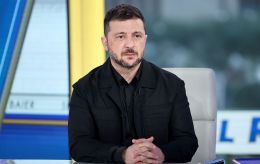Shock tactics: What makes today's Russian attack on Ukraine unusual and when next strike might occur
 Photo: Rescuers dismantle debris at the site of a strike in Kyiv (Vitalii Nosach/RBC-Ukraine)
Photo: Rescuers dismantle debris at the site of a strike in Kyiv (Vitalii Nosach/RBC-Ukraine)
On July 8, Russia launched mass rocket strikes against Ukraine. For the first time in a long while, the attacks occurred during the day, had a wave-like pattern, and resulted in casualties in Kyiv, Dnipro, Kryvyi Rih, and the Donetsk region.
For more details on the enemy's tactics, their objectives, and when the next mass strike could occur, refer to the material by RBC-Ukraine.
Contents:
- Headlines on the aftermath of the rocket attack on July 8
- Why there were constant alarms and what was Russia's goal
- Peculiarities of the attack, tactics, and when a new mass strike may occur
Headlines on the aftermath of the rocket attack on July 8
During the night of July 8, Russia launched four Kh-101 missiles from strategic aviation and two ballistic Iskander missiles. Ukrainian air defense forces managed to intercept three cruise missiles in the Zhytomyr and Cherkasy regions.
From approximately 10:00 a.m., combined attacks commenced involving air, sea, and ground-based missiles. These attacks were characterized by wave-like patterns, with air raid sirens sounding at least four times by midday.
Russian forces used 38 missiles, 30 of which were shot down. Targets included the aeroballistic Kinzhal, three out of four ballistic Iskander-M missiles, 11 out of 13 Kh-101 cruise missiles, 12 out of 14 Kalibr cruise missiles, and three Kh-59/Kh-69 aviation missiles.
Overall, more than 30 people lost their lives, and over a hundred were injured. In Kyiv alone, 22 fatalities occurred, making today's attack the deadliest in the capital since the beginning of 2024.
The largest children's hospital in Ukraine, Okhmatdyt, was hit, damaging its facilities and causing the deaths of at least two individuals, with ongoing rescue efforts at the site.
For more details on the aftermath, read the full report on RBC-Ukraine.
Additionally, debris fell in other areas of the capital. An office building was damaged, and there were reports of fires in a private home and a high-rise apartment building. In Sirets, the entrance of a five-story building collapsed. In the latter half of the day, debris damaged the family clinic Isida on the left bank, where the casualties were reported.
Several strikes were recorded in Kryvyi Rih, including one on an administrative building of a company, resulting in at least 10 deaths. In Dnipro, a nine-story building's roof and technical floor were destroyed, windows were shattered in apartments, and a vehicle maintenance facility and enterprise were damaged. One casualty was reported. Three more individuals lost their lives in Pokrovsk, the Donetsk region.
The Russian Ministry of Defense cynically labeled the strikes as responses to drone attacks on energy facilities, claiming alleged damage to airbases and industrial enterprises, and blamed Ukrainian air defense for the deaths of civilians.
Ukraine has initiated an emergency session of the UN Security Council.
Why there were constant alarms and what was Russia's goal
The attack on Kyiv was massive, combined with the use of aeroballistic, ballistic, and cruise missiles. Missiles flew towards the capital from various directions.
Military-political observer of the Information Resistance group, Oleksandr Kovalenko, explains why the attacks came in waves, triggering alarm after alarm.
According to him, at first glance, it might seem that they were not synchronized. But most likely, such synchronization was not the goal because Russia aimed to create a continuous wave-like effect.
"To prolong the element of terror as long as possible. At the same time, we see that strikes were made in Kryvyi Rih, Dnipro, and Sloviansk-Kramatorsk agglomeration. They did not concentrate the entire strike, for example, on Kyiv. Therefore, it is about mass terror rather than tactical or strategic efficiency," he told RBC-Ukraine.
Former spokesperson of the General Staff of the Armed Forces of Ukraine, Vladyslav Seleznov, believes that Russian propaganda statements about targeting Patriot air defense systems, command posts, and equipment concentration areas should not be taken seriously.
Because the effect is obvious - only in Kyiv, three substations were damaged or destroyed, a business center, Lukyanivska metro station (near which there are many shops), residential buildings, and Okhmatdyt. Such attacks always result in civilian casualties, but these victims are of no concern to the Russians, the expert noted.
"We must understand the following: right now, the enemy is implementing a strategy of shock and awe. Putin, on the eve of the NATO summit, is trying to show the world that he is ready to go all the way and that no one will stop him. To provoke the maximum emotional reaction, he kills children at Okhmatdyt and women in maternity hospitals. These are our most vulnerable citizens," Seleznov explained.
What does Putin achieve? Acceptance of ultimatum conditions. He effectively demands Ukraine's capitulation, insisting on control over six regions - Sevastopol, Crimea, Luhansk, Donetsk, Kherson, and Zaporizhzhia regions.
"And to accomplish this mission, he acts by killing civilians. Because when he talks about targeting military objects, it's at best misleading. What military objects, if the strikes hit medical facilities and residential buildings? There was no mention of strikes on military targets," he added.
At the same time, Kovalenko notes that such massive attacks are planned in advance, so it's difficult to definitively say whether today's events are somehow linked to the NATO summit or Zelenskнy's trip.
"The targets are formed in advance. Russians don't just decide out of the blue, 'Let's have a missile genocide tomorrow.' Preparation of munitions, aviation, trajectory calculations, all start approximately two weeks beforehand," the interlocutor said.
Peculiarities of the attack, tactics, and when a new mass strike may occur
According to a representative of Ukrainian Air Force Yurii Ihnat, Russia is constantly improving its missiles. As a result, they are becoming harder to detect and intercept, due to additional radar and thermal traps. Today, cruise missiles flew at ultra-low altitudes, with combat operations conducted at an altitude of up to 50 meters, which can also have terrible consequences on the ground.
Seleznov emphasizes another point: the missiles changed directions. For instance, the Kh-101 came to Okhmatdyt from the north, approaching from the Vyshhorod and Kyiv Sea side. It's also possible that the trajectory was quite unusual.
"Some missiles in the morning moved towards Zhytomyr. Considering the nighttime attack on its outskirts, one might have thought they would again target military infrastructure. However, after some time, they turned and approached Kyiv from the west to bypass our air defense," he explained in an interview.
The Russians are exploring every opportunity to overcome air defense systems, so underestimating the enemy is not advisable.
"Note how many additional Patriot batteries have been promised to us, but we have only received one from the German government. When others will arrive is unknown. The lack of sufficient air defense means, including creating a deadly danger for people who have nothing to do with the defense forces. Russia is killing them," he emphasized.
Oleksandr Kovalenko points out similarities to the early June attack when over 50 missiles were used.
"Today is July 8th. Most likely, they have a periodicity of mass attacks - a month. This is a feature. Then, every 2-5 days, they launch significantly fewer, at a minimum level. Currently, this is their tactics for striking," the expert believes.
The monthly periodicity may be related to Russian missile stocks and production rates. Regarding stocks, according to intelligence information as of May, the enemy had about 40 Zircons, 400 Onyxes, 240 Kalibrs, 25 Kh-59 missiles, at least 150 Kh-22, 80 Kinzhal missiles, about 300 Iskander-M and Iskander-K missiles.
"That's a lot; they produce a huge number of missiles. Considering there haven't been mass attacks recently, this must be taken into account. We're talking about hundreds, maybe thousands of missiles available for combined strikes. Today, there were Kinzhal, Iskanders, Kalibrs, and Kh-101s - a wide range to overload and surpass our air defense and guaranteed to achieve terrorist goals," Vladyslav Seleznov noted.
Kovalenko leans towards the idea that the next mass attack could happen in about a month.
"As we observe, at the beginning of each month, the occupiers initiate mass strikes. However, throughout the month, we will see smaller launches with a periodicity of approximately 2-5 days, involving a smaller set of 5-10, up to 15 missiles of various types," summarized the expert.
Sources: data from Telegram channels of regional authorities, announcements from the Air Force, statements from a representative of Ukrainian Air Force Yurii Ihnat, and comments from military experts Vladyslav Seleznov and Oleksandr Kovalenko.

